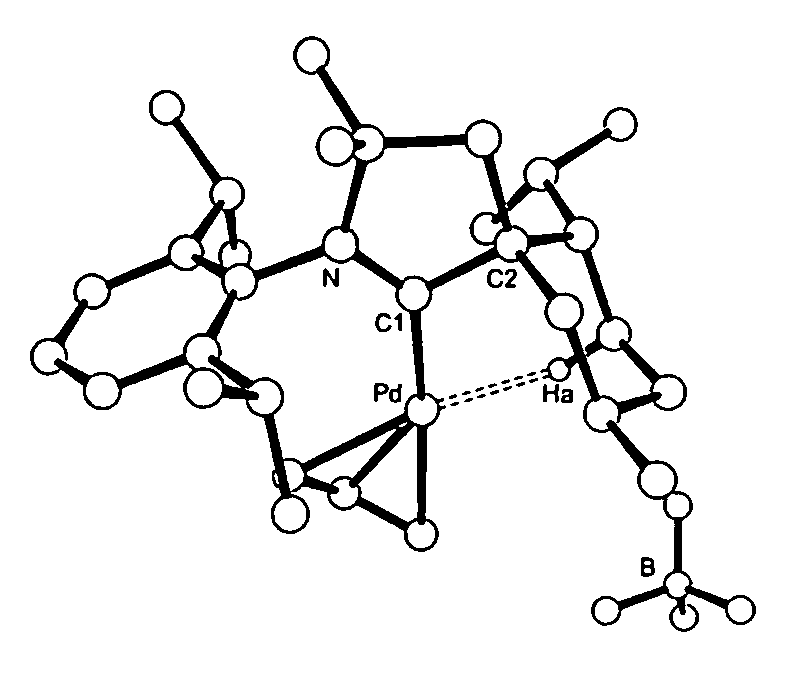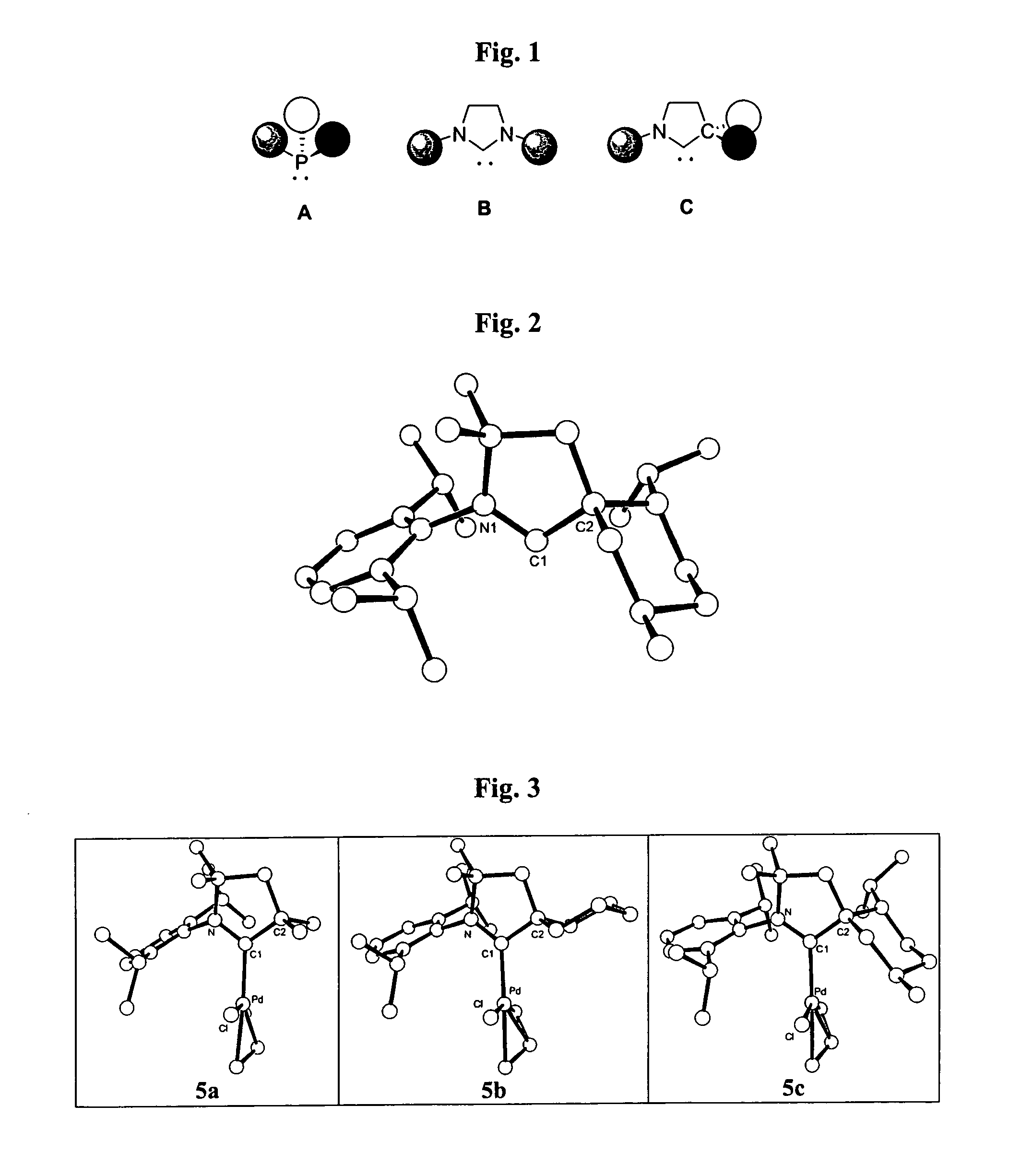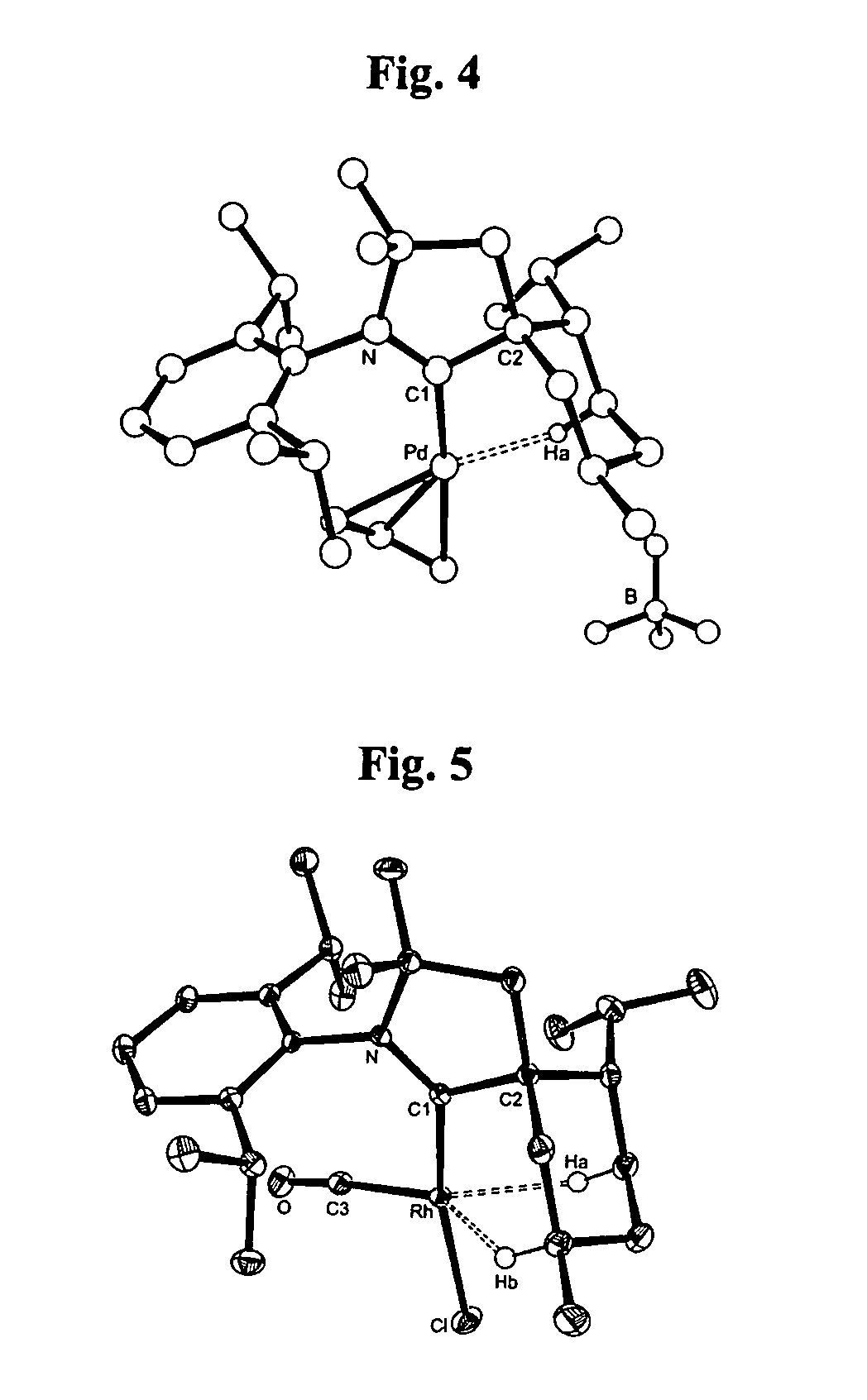Stable cyclic (alkyl)(amino) carbenes as ligands for transition metal catalysts
a technology of cyclic (alkyl) carbenes and transition metal catalysts, which is applied in the direction of organic compounds/hydrides/coordination complexes, physical/chemical process catalysts, organic compounds/chemical process catalysts, etc., can solve the problems of bulky reactant coupling and excess steric hindrance,
- Summary
- Abstract
- Description
- Claims
- Application Information
AI Technical Summary
Benefits of technology
Problems solved by technology
Method used
Image
Examples
example 1
[0084]This example provides the preparation of selected Imines 1.
[0085]
[0086]Imine 1a has already been described (Brookhart, M.; Daugulis, O. PCT Int. Appl. (2003), CODEN: PIXXD2 WO 2003078478 A1 20030925).
[0087]Imine 1b: In a schlenk tube containing activated molecular sieves (3 g), the aldehyde (7.13 mL, 59.2 mmol) was added dropwise to a solution of 2,6-diisopropylaniline (10.0 g, 56.4 mmol) in toluene (60 mL). The suspension was stirred for 12 hours at room temperature. After filtration, the molecular sieves was washed with hexane (30 mL). Evaporation of the solvent under vacuum, afforded 1b as a white solid, which was recrystallized in pentane at 0° C. (13.75 g, 90%, m.p. 93-95° C.). 1H NMR (CDCl3, 25° C.): 7.51 (d, 1H, CH, J=4.8), 7.04-7.14 (m, 3H, Har), 2.95 (sept, 2H, CHCH3, J=6.9), 2.47 (m, 1H, CH), 2.00 (m, 2H, CH2), 1.87 (m, 2H, CH2), 1.75 (m, 1H, CH2), 1.20-1.50 (m, 5H, CH2), 1.17 (d, 12H, CHCH3, J=6.9). 13C NMR (CDCl3, 25° C.): 171.26 (CH), 149.28 (Car), 137.73 (Car), 1...
example 2
[0090]This example provides the preparation of Iminium salts 3.
[0091]
[0092]Iminium salt 3a: A solution of LDA (4.66 g, 43.5 mmol) in Et2O (40 mL) was added at 0° C. to a stirred solution of imine 1a (10.05 g, 43.5 mmol) in Et2O (40 mL). The solution was warmed up to room temperature and stirred for 2 hours. After evaporation of the solvent under vacuum, the residue was dissolved in Et2O (80 mL), and 1,2-epoxy-2-methylpropane (4.06 mL, 45.7 mmol) was added dropwise. After stirring for 12 hours at room temperature, trifluoromethane sulfonic anhydride (Tf2O) (7.68 mL, 45.7 mmol) was added at −78° C. The solution was warmed to room temperature and stirred for 1 hour. After filtration, the remaining solid was washed with Et2O (80 mL). Extraction with CH2Cl2 (40 mL) afforded 3a as a white solid (10.99 g, 58%, m.p. 198-200° C.). 1H NMR (CDCl3, 25° C.): 9.48 (s, 1H, CH), 7.53 (m, 1H, Har), 7.34 (m, 2H, Har), 2.63 (sept, 2H, CHCH3, J=6.9), 2.43 (s, 2H, CH2), 1.68 (s, 6H, CH3), 1.54 (s, 6H, C...
example 3
[0099]This example illustrates the preparation of representative carbenes.
[0100]Carbene Ca: A 1 / 1 mixture of LDA and iminium salt 3a (5.0 mmol) was cooled to −78° C. and 30 mL of THF was added. The suspension was warmed to room temperature and stirred for 30 min. After evaporation of the solvent under vacuum, a solid residue containing Ca and LiOTf was obtained and used for the complexation reaction without further purification. 13C NMR (thf-d8, 25° C.): 304.22 (C), 145.81 (Car), 137.51 (Car), 128.05 (Car), 123.77 (Car), 82.47 (C), 57.75 (C), 50.35 (CH2), 29.09, 28.89, 27.49, 21.75.
[0101]Carbene Cb: A 1 / 1 mixture of LDA and iminium salt 3b (5.0 mmol) was cooled to −78° C. and 30 mL of THF was added. The suspension was warmed to room temperature and stirred for 30 min. After evaporation of the solvent under vacuum, a solid residue containing Cb and LiOTf was obtained and used for the complexation reaction without further purification. 13C NMR (thf-d8, 25° C.): 309.43 (C), 145.80 (Car...
PUM
 Login to View More
Login to View More Abstract
Description
Claims
Application Information
 Login to View More
Login to View More - R&D
- Intellectual Property
- Life Sciences
- Materials
- Tech Scout
- Unparalleled Data Quality
- Higher Quality Content
- 60% Fewer Hallucinations
Browse by: Latest US Patents, China's latest patents, Technical Efficacy Thesaurus, Application Domain, Technology Topic, Popular Technical Reports.
© 2025 PatSnap. All rights reserved.Legal|Privacy policy|Modern Slavery Act Transparency Statement|Sitemap|About US| Contact US: help@patsnap.com



